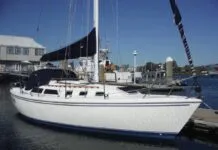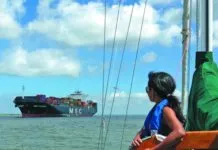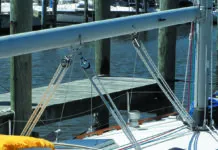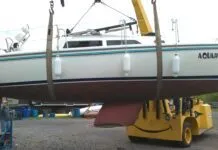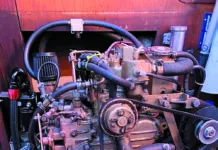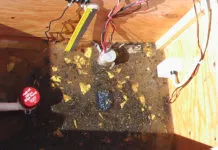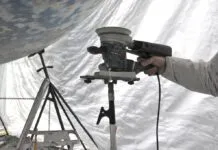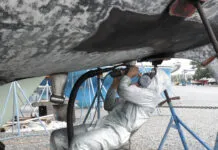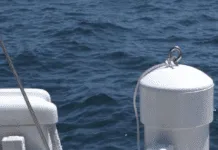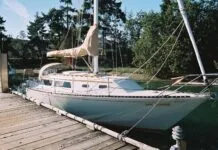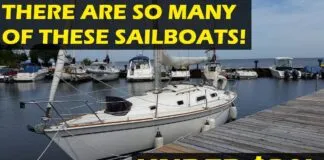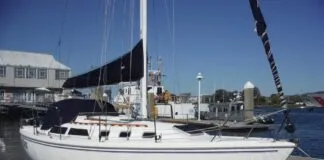By midwinter, when the North is suffocated by snow and ice and lakes in the upper Midwest are frozen, it’s just too damned cold to sail. Out West, in rain country, low-pressure systems produce either nasty storms or dead calms.
An option to sitting by the fireplace lamenting the predicament or rereading back issues of Practical Sailor is to book a sailing adventure on a charter boat.
Selecting a charter firm based on marketing brochures, however, may present a challenge, because there’s a tremendous difference between the quality of the boats and services offered. Most differences are attributable to financial considerations.
Because the British Virgin Islands in the Caribbean are closer than the South Pacific or Mediterranean, we traveled to Road Town, Tortola, to check out a handful of the operators in this popular cruising ground.
Choices…
Charter bookings are offered in three flavors. For the experienced skipper, bareboating is an option if youre confident of your sailing and navigational skills. Since most sailing is line of sight, and nighttime sailing is prohibited, this isn’t as daunting as it may appear at first blush.
For the less adventurous, bigger charter outfits offer the option of traveling in a flotilla with a skipper tagging along on a support boat. This approach eliminates worries associated with navigation and provides local knowledge and assistance with anchoring or mechanical problems.
The third option is to hire a skipper, sit back, and worry only about the timing of departures and the lunch menu. This is an excellent way to have a tutor assist in honing sailing skills; a skipper also may find out-of-the-way places less frequented by tourists, and weather holes in a blow.
Major Operators in the BVI
Of the 32 charter operators in the British Virgins, the three largest are SunSail, The Moorings and Sun Yachts. They operate at the top of a business community that is divided into several tiers. Second-tier companies, like Footloose, a subsidiary of Moorings, and third-tier companies like Conch Charters, Ltd., from whom we chartered, buy used boats and put them into smaller fleets.
Top-tier companies cater to a clientele who pay 10%-15% higher fees for newer boats and added frills. At the other end of the scale are older boats rented at reduced prices. The philosophy here is that the savings makes a trip affordable by offsetting travel expenses.
Not surprisingly, theres a fair amount of job hopping between companies by managers of these operations, so there are few trade secrets among them.
The Moorings fleet, consisting of 200 boats at two locations, is the largest, and typifies first-tier companies. Boats are 35-70 feet. Hunter, Jeanneau, Beneteau and Dufour are the most prevalent brands.
Of equal importance is the size of the maintenance staff. The Moorings has a staff of 150, SunSail 65-70 and Sun Yachts has 45 full-timers. These numbers are proportionate to the number of boats in charter.
Most staffs are divided into a group of starts or mechanics, shipwrights, riggers, and interior cleaners; and, maintenance technicians, who solve service electrical and mechanical problems.
By comparison, Conch Charters, Ltd., rents 30 boats of various pedigrees, 20 of which are 13 years old. The staff of 14 includes three in the office. The dock staff is adequate for the task of preparing boats and performing minor maintenance chores. Outside technicians are hired to handle serious mechanical ailments.
How They Operate
The charter industry is like a three-legged stool that satisfies the needs of individuals interested in boat ownership; companies interested in managing fleets to make money; and vacationers.
A typical arrangement involves a charter company that sells or leases a new boat to an individual. The vessel is made available for charter in the company fleet for a period of 4-5 years, which generates cash flow and profits for the charter company. The arrangement also generates cash flow, the possibility of tax incentives, and free sailing vacations for the owner.
At the end of the charter period, the boat is returned to the owner or sold on his behalf, and an attempt is made to sell him a new boat.
Hence, the commitment to good maintenance.
Mike MacLean, who manages the SunSail operation, says, Our philosophy is to fix things before they break, and give the owner a five-year-old boat that still has 60% of its useful life in sails and dinghy. Consequently, their maintenance procedures could be a model for any boat owner.
Our checklist includes everything from clevis pins and door latches to switches, sail furlers, and anchor windlass, MacLean says.
Plus, after every 12 trips we check or change steering cables, impellers, oil and filters, and belts. For most boats, 12 trips is a years use; for us its 12 weeks of a 25-35 week season.
Similarly, The Moorings pre-trip checklist includes a three-page punch list with 60 different items and procedures, exclusive of outfitting the boat, varnishing dings, scrubbing decks and vacuuming the cockpit.
Some operators haul boats to inspect and paint bottoms every six months.
In addition, each trip is concluded with a debriefing of the skipper by a maintenance crew chief.
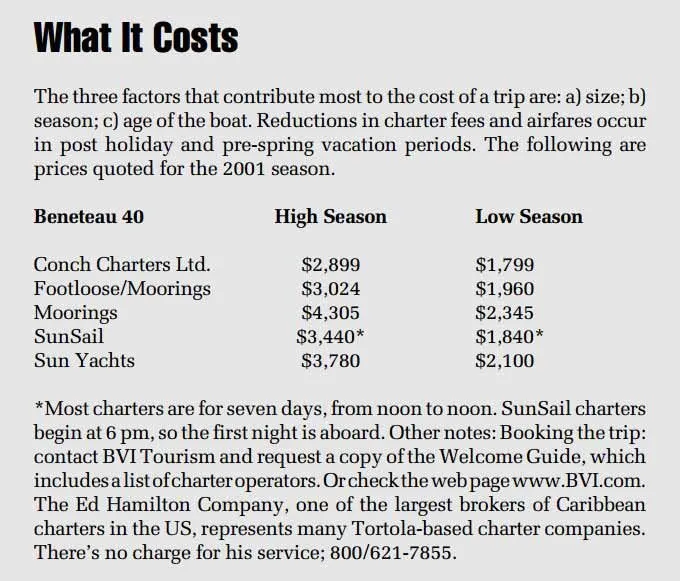
The Boats
The majority of the sloops are built to charter company specifications for use in the Virgins, Mediterranean and South Pacific. Consequently, the operators have a significant influence on boat company production; one company was taking delivery of 70 factory-new boats within two weeks of our visit, and shipping 50 older boats to an overseas base.
Since the typical client is a family or pair of cruising couples, the boats typically have large cockpits and multiple staterooms and heads.
They also may place proprietary names on particular models; a Beneteau 40 sold in the U.S. may be a Moorings 4000 in the Virgin Islands.
Similarly, a cookie cutter approach is taken to equipment. All feature roller furling, slab reefing and lazy jacks; many have a Stackpack or equivalent for the mainsail. Headsails are 120%- 150% genoas, adequate for sailing to weather but requiring high pointing angles downwind. We could not find a boat outfitted with a spinnaker.
We intentionally depower boats by using slightly smaller sails and a furler tack 18 inches above the deck, MacLean says. Our objective is user-friendly performance.
Galleys and spaces belowdecks are adequate for week-long cruises. Most are equipped with necessary cooking and eating utensils, and a cleanup kit, so all a crew needs to add are provisions. They typically have hot and cold pressure water systems, propane stoves and refrigerators; some are equipped with a freezer.
Because all of the sailing is line of sight, the area is well charted, and sailing at night is prohibited, electronics consist of VHF radios, depth sounders and knotmeters. Most operators now provide a cellular telephone for use in an emergency. Some boats are equipped with an autopilot, and GPS may be offered as an option. Newer boats have CD players rather than cassette players, so music in the cockpit adds to the environment.
A rigid inflatable or fiberglass dinghy powered by a 5-horsepower outboard motor is included in the base rate; ours had seen better days, but conveyed four passengers safely to shore. Snorkeling gear for the entire crew also is included.
A weeks worth of diesel fuel and full water tanks are provided. However, expect to pay exorbitant rates for every drop of water once those tanks empty.
The Routine
The benefit of paying a higher price of admission at a first-tier company becomes evident the moment you arrive at the marina, which has the feel of a resort. A welcoming handshake may be followed by a cold beverage with an umbrella in it, and canvas gear bag.
By comparison, Conchs office was located upstairs over a machine shop.
Because the objective of the operator is to get boat and crew out and back in one piece, heavy emphasis is placed on navigation. At Sun Yachts, group orientation sessions are conducted; these consist of a video presentation describing the area and are followed by individual meetings with crew and skipper, during which an itinerary is developed.
Top-tier operators include bound travel guides with extensive descriptions of anchorages, dive sites, shoreside attractions, restaurants, and waterproof charts.
By comparison, the Conch briefing took place on the veranda of a nearby restaurant, during which time notes were made on a photocopy of a chart. The form wasnt top drawer, but the substance was adequate.
The navigation session is followed by an onboard explanation of the ships operating systems. Ours took an hour and included operation of the engine, plumbing, galley and navigation systems. Anchoring techniques and operation of the tender and outboard were emphasized to prevent fouling the dinghy painter in the prop.
Troubleshooting
An important criterion in assessing any charter operation is the system for providing assistance when mechanical problems are encountered.
Sun Yachts approach is typical of top-tier operators.
We have three chase boats equipped with 80-horsepower motors that allow us to reach most anchorages in one hour, says Andrew Johnson, operations manager. And we have telephones aboard so its a free call to the base. We typically arrive within three hours. If a client is delayed four hours, they begin accumulating free sailing days.
Our boats have onboard the same troubleshooting manual as is used by our support crews, says SunSails MacLean, so a skipper with a mechanical bent can solve most problems.
The greatest problems tend to be associated with skipper ego, the two agreed.
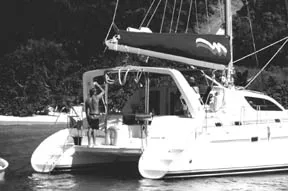
The first is the amount of time people need to decompress to fully enjoy the experience, Johnson says. And people tend to exaggerate their skills.
The clues are when they ask the wrong questions during the briefing, MacLean says.
Charter operators usually reserve the right to place a skipper aboard for the first day, at no expense, to evaluate the crew.
The perception is that its a portable vacation, but it can turn to action in a hurry, MacLean continues. My advice is to know your limitations and ask questions. The focus should be on having fun and avoiding problems.
Our Experience
We were aware at the outset that Conch Charters offered Chevy, not Cadillac, quality products, but didnt expect so many dents.
Our sloop was a nine-year-old 37-footer equipped with two staterooms and two heads. Suffering more use in one season than a typical boat does in a lifetime, and lacking the TLC or money of a typical recreational sailboat, she showed her age and use as a business venture.
Upon arrival we were greeted by such a strong smell of diesel fumes emanating from the bilge that we were reluctant to leave the dock. We checked with a maintenance person, who agreed with our suspicion that the boat had just returned from charter and that the turnaround time had been short. That explained the discovery in one drawer of the previous charterers underwear.
With some cajoling, the maintenance person agreed that we shouldnt be expected to put up with the fumes for seven days. We eventually had a sweet-smelling boat but suffered a one-hour delay. That allowed time to sort through bins of mismatched fins, masks and snorkels in an attempt to find four matching pairs. We eventually succeeded.
During the ensuing seven days we discovered that the boat suffered from a lengthy list of maladies, including exposed wires on light fixtures; a speedo that didnt work; lack of a windspeed instrument; sheets that did not fit a berth; torn vinyl cushions; a forward head too odiferous to use; a rusty seacock handle that would soon break…
Sailing to weather was a challenge because the sails were used beyond reasonable life expectancy, and she would only tack through 110 degrees. Reefing lines were led backwards, which we discovered when we attempted to shorten sail.
Our most exciting event occurred when the engine died while we were searching for an anchorage. This at least presented an opportunity to practice sailing onto a mooring.
Attempting to contact the base using the cell phone, we got an answering machine on our first two attempts. We eventually made contact, and a boat mechanic who happened to be in the area was dispatched. He arrived an hour later, repaired a failed thermostat, and we were back in business.
Its boats and wind and saltwater, and people and things break, he said.
Had we called 15 minutes later, the office would have been closed and we would have been out of commission most of the next morning.
Next time well think about chartering from an operator with a 24-hour switchboard.
Conclusions
When considering a week-long cruising vacation in saltwater, we think selecting a first- or second-tier operator is a good choice, though they charge a premium for their product.
The operators motivation is to keep an owner financially happy by generating cash flow through repeat business. Boats are newer. Docks are covered with teams of boat maintenance workers working well-choreographed routines.
Conversely, lower-tiered operators operate with less cash flow, have smaller, older fleets, and smaller staffs charged with shorter turnaround times on every boat. A week is a long time to share a small space with diesel fumes and the cachet of a previous charterers soiled laundry.
But was the sailing okay? Did we escape the ice and snow for a week? Did the rum taste good? Did we save $500-$800? Yes, on all counts.
Contacts- Conch Charters, PO Box 920, Road Town, Tortola, BVI; 800/521-8939, Canada 800/463-6625. Footloose Sailing Charters/The Moorings, 19345 US Highway 19N, 4th Floor, Clearwater, FL 33764-3193; 888/703-3176. Sunsail, 1045B Riverside Dr., Palmetto, FL 34221; 800/797-5307. Sun Yacht, PO Box 4035, Portland, ME 04101; 207/253-5400.
1. Don’t be too aggressive. Charter a boat the size you typically sail. If you’re a novice, be sure the training you receive at a sailing school has prepared you to sail in rough conditions. Tradewinds blow hard.
2. Age may be the most important criterion in selecting a vessel.
3. Evaluate the policy regarding response time when you’re disabled. Expect a guarantee of service within four hours maximum.
4. Don’t rely on friends for good advice; their definition of “very good” may be different than yours.
5. Travel light and carry soft luggage.
6. More expensive trips are worth the money. However, if the choice is between chartering from a second or third-tier operator and staying home, take the trip.
This charter occurred in April, which is one of the industry’s biggest months due to rate specials, and yes, turnaround can be very tight for charter companies. Bilge smells are very personal, and as noted, we solved this problem before the yacht left the dock.
The engine overheating problem was due to a sticking thermostat. This, as we all know, is a situation that is impossible to detect until it happens, and is quite rare. At the end of all our charters we have a checkout sheet which has a section for customers’ comments. The charterer wrote congratulating our staff member for the way in whichhe managed the engine overheating situation.
Conch Charters is entering its 15th successful year, with a fleet of 30 yachts, and has one of the largest percentages of satisfied repeat customers who appreciate good value for money. The items above are regrettable, and I assure your readers they are not typical of our usual high standards of maintenance.
Brian R. Gandey
Owner, General Manager
“I’ve used Moorings several times. We pay more for a newer, solid boat that has been well-maintained. We hire a skipper who knows how to avoid the crowds and avoid the reefs, and which restaurants are good.”
– A French gentleman traveling with his wife and two children
“We’ve used the big operators and the mid-priced operators, and settled on Conch Charters because the money we save pays for airfare. Their 2-for 1- package gives us an extra week of sailing.”
– Midwest client of Conch Charters, Ltd.


